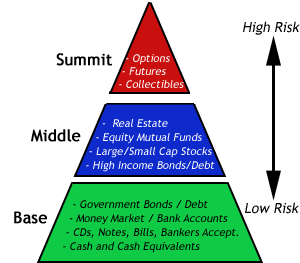Risk tolerance is the degree of uncertainty that you can handle in regard to a negative change in the value of your portfolio. While investing you may often have to do a risk-return tradeoff, the principle that potential return rises with an increase in risk. With so many different types of investments to choose from, how do you determine how much risk you can handle?
Many investors do not understand how to determine the level of risk their individual portfolios should bear. This article provides a general framework that any investor can use to assess his or her personal level of risk and how this level relates to different investment classes.
Low levels of uncertainty (low risk) are associated with low potential returns, whereas high levels of uncertainty (high risk) are associated with high potential returns. According to the risk-return tradeoff, invested money can render higher profits only if it is subject to the possibility of being lost.
Because of the risk-return tradeoff, you must be aware of your personal risk tolerance when choosing investments for your portfolio. Taking on some risk is the price of achieving returns; therefore, if you want to make money, you can’t cut out all risk. The goal instead is to find an appropriate balance – one that generates some profit, but still allows you to sleep at night.
Anytime you invest money into something there is a risk, whether large or small, that you might not get your money back. In turn, you expect a return, which compensates you for bearing this risk.
An investor’s risk tolerance varies according to age, income requirements, financial goals, etc. For example, a 65-year-old retired person will generally have a lower risk tolerance than a single 28-year-old executive, who generally has a longer time frame to make up for any losses he may incur on his portfolio.
Determining Your Risk Preference
Every individual is different, and it’s hard to create a steadfast model applicable to everyone, but here are two important things you should consider when deciding how much risk to take:
1. Investment Time Horizon
Before you make any investment, you should always determine the amount of time you have to keep your money invested. If you have Rs.50,000 to invest today but need it in one year for a down payment on a new house, investing the money in higher-risk stocks is not the best strategy. The riskier an investment is, the greater its volatility or price fluctuations, so if your time horizon is relatively short, you may be forced to sell your securities at a significant a loss.
With a longer time horizon, investors have more time to recoup any possible losses and are therefore theoretically be more tolerant of higher risks. For example, if that Rs.50,000 is meant for a holiday home that you are planning to buy in ten years, you can invest the money into higher-risk stocks because there is be more time available to recover any losses and less likelihood of being forced to sell out of the position too early.
2. Financial Situation
Determining the amount of money you can stand to lose is another important factor of figuring out your risk tolerance. This might not be the most optimistic method of investing; however, it is the most realistic. By investing only money that you can afford to lose or afford to have tied up for some period of time, you won’t be pressured to sell off any investments because of panic or liquidity issues.
The more money you have, the more risk you are able to take and vice versa. Compare, for instance, a person who has a net worth of Rs.100,000 to another person who has a net worth of Rs.1,000,000. If both invest Rs.50,000 of their net worth into securities, the person with the lower net worth will be more affected by a decline than the person with the higher net worth. Furthermore, if the investors face a liquidity issue and require cash immediately, the first investor will have to sell off the investment while the second investor can use his or her other funds.
Investment Risk Pyramid
 After deciding on how much risk is acceptable in your portfolio by acknowledging your time horizon and financial situation, you can use the risk pyramid approach for balancing your assets.
After deciding on how much risk is acceptable in your portfolio by acknowledging your time horizon and financial situation, you can use the risk pyramid approach for balancing your assets.
This pyramid can be thought of as an asset allocation tool that investors can use to diversify their portfolio investments according to the risk profile of each security. The pyramid, representing the investor’s portfolio, has three distinct tiers:
- Base of the Pyramid– The foundation of the pyramid represents the strongest portion, which supports everything above it. This area should be comprised of investments that are low in risk and have foreseeable returns. It is the largest area and composes the bulk of your assets.
- Middle Portion– This area should be made up of medium-risk investments that offer a stable return while still allowing for capital appreciation. Although more risky than the assets creating the base, these investments should still be relatively safe.
- Summit– Reserved specifically for high-risk investments, this is the smallest area of the pyramid (portfolio) and should be made up of money you can lose without any serious repercussions. Furthermore, money in the summit should be fairly disposable so that you don’t have to sell prematurely in instances where there are capital losses.
Personalizing the Investment Risk Pyramid
Not all investors are created equally. While others prefer less risk, some investors prefer even more risk than others who have a larger net worth. This diversity leads to the beauty of the investment pyramid. Those who want more risk in their portfolios can increase the size of the summit by decreasing the other two sections, and those wanting less risk can increase the size of the base. The pyramid representing your portfolio should be customized to your risk preference.
It is important for investors to understand the idea of risk and how it applies to them. Making informed investment decisions entails not only researching individual securities but also understanding your own finances and risk profile. To get an estimate of the securities suitable for certain levels of risk tolerance and to maximize returns, investors should have an idea of how much time and money they have to invest and the returns they are looking for.


I really like the concept of the Investment Risk Pyramid. It allows me to diversify my investments effectively and efficiently based on my investment choices and risk tolerance. As a new trader in the stock market, I will ideally have a large bulk in the base of the pyramid or 50% of my entire portfolio, 40% middle tier and only 10% on the summit which will consist only either of collectibles or futures. Option trading is too much for me (risk) this time and I know little about it. So, that is my fund allocation.
Thank you for sharing me wonderful ideas. More Power!